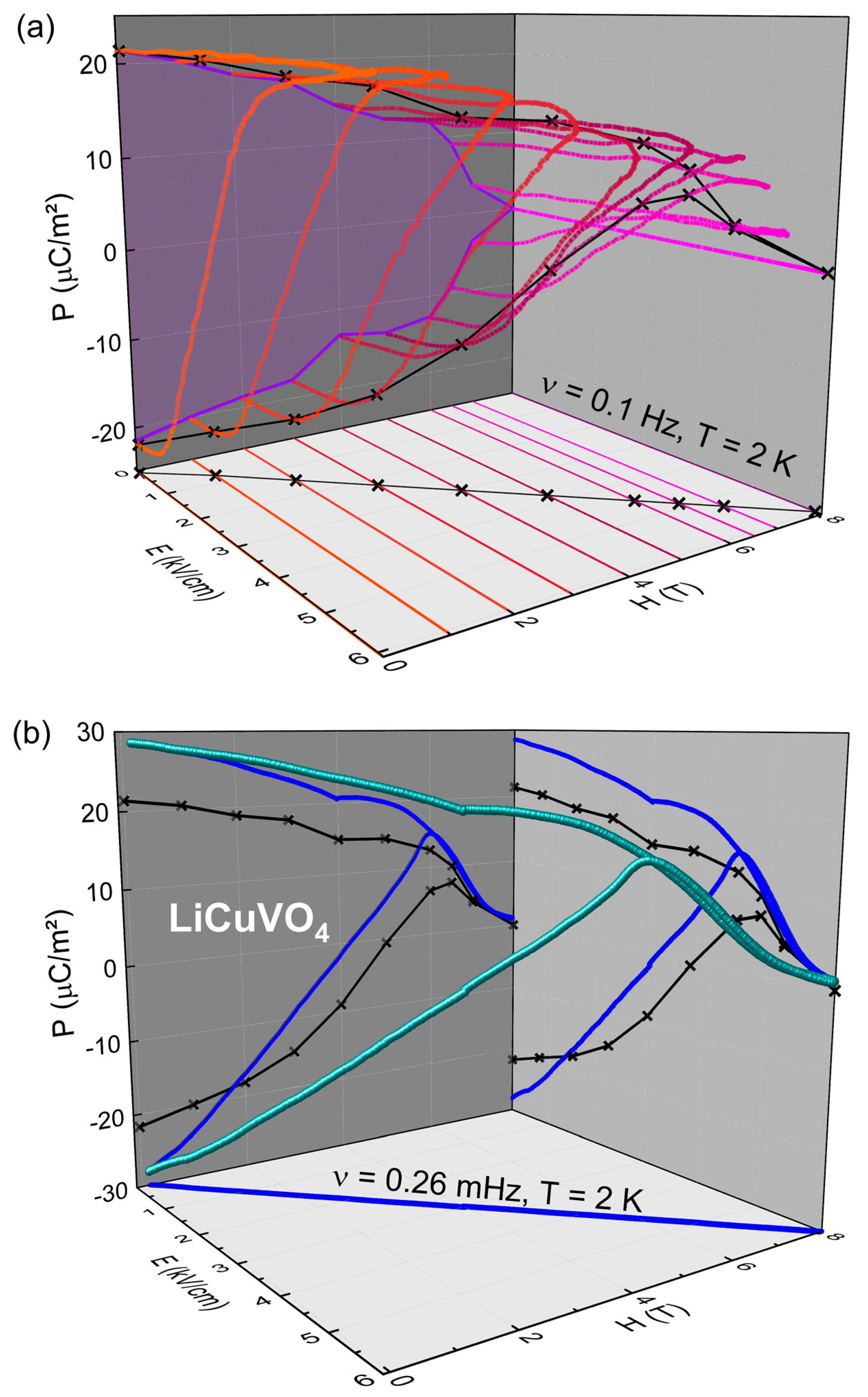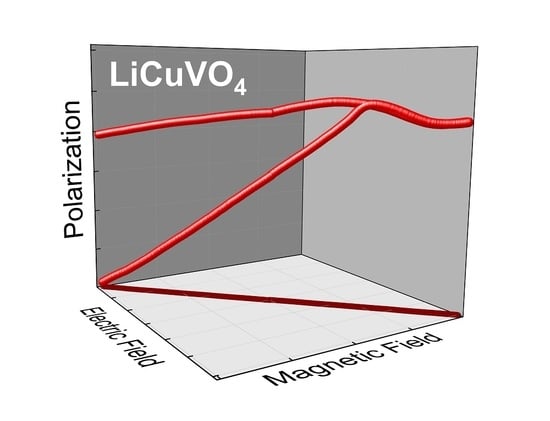1. Introduction
In the last years, multiferroic materials established a very important field of materials science as they host inherent functionalities for novel electronic and magnetic devices [
1]. Among these materials, those who exhibit both ferroelectric and (anti-)ferromagnetic order, are most prominent as they usually exhibit large magnetoelectric effects [
2,
3]. Controlling the magnetic order via an electric field and vice versa is a challenging task. Especially, systems with spin-driven ferroelectric order formed by spiral or helical spin structures enable this approach [
4,
5,
6]. The electrical polarization arises directly from the non-collinear spin structure, for which LiCuVO
4 is a prototypical example [
4,
6,
7,
8]. As proposed, e.g., in Refs. [
9,
10,
11], the presence of tilted spins (
Si and
Si+1) at neighboring atomic sites (
i and
i + 1) breaks the inversion symmetry via spin-orbit coupling and is the microscopic mechanism for multiferroicity in these systems. This spin-driven improper ferroelectricity leads to the following relation for the electrical polarizat ion:
P ∝
e ×
Q, where
Q denotes the propagation vector of the spin spiral and
e = (
Si ×
Si+1) corresponds to the spiral axis, i.e., the normal vector of the spiral spin plane [
7,
10,
11,
12].
The spin-driven multiferroic compound LiCuVO
4 exhibits a complex (
H,
T)-phase diagram for the polarization at low temperatures [
7]. An external magnetic field in
c direction (
H1 ≈ 2.5 T <
H <
H2 ≈ 7.5 T) is able to gradually induce conical spin structures continuously decreasing the spin-driven polarization along the
a direction, perpendicular to the external field. For increased magnetic fields (
H >
H2), a modulated collinear spin structure is established [
13], which suppresses the helical spin state and electric polarization. Without an external magnetic field, the spin spiral in LiCuVO
4 is formed below
TN = 2.5 K in the
ab-plane (spiral axis
e ‖
c) and propagates in the crystallographic
b direction (i.e.,
Q ‖
b) [
7,
8]. As predicted by theory (e.g., Refs. [
10,
12]) and confirmed by experiments (e.g., Refs. [
7,
14]) this leads to a ferroelectric polarization along
P ‖
a. Above
H1,
e aligns along the external magnetic field direction, which is accompanied by spin flops if
H is not along the easy axis (i.e.,
c). This allows switching the direction of the electrical polarization according to
P ∝
e ×
Q. Accompanied by the transition into the modulated collinear spin state, above
H2 the ferroelectric state vanishes. Interestingly, not only the magnetic field has an impact on the polarization of a LiCuVO
4 single crystal but also an external electrical field [
14]. This field can switch the ferroelectric polarization in
a direction from +
Pa to −
Pa implying that the spin helicity switches from clockwise to counter-clockwise and vice versa. Such ferroelectric hysteresis loops have only rarely been documented in spin-spiral multiferroics [
3,
4,
14,
15,
16].
In the present work, we thoroughly analyze the electric and magnetic field dependent ferroelectric hysteresis loops of single crystalline LiCuVO
4. Special emphasis is put on two aspects: firstly, the frequency dependence of ferroelectric hysteresis shows that the polarization varies with respect to frequency and coercive field. We provide a fundamental basis, using the Ishibashi-Orihara theory for domain-wall movements [
17], to explain the presence of multiferroic domains (clockwise and counterclockwise spin-spirals). This allows further insights into the dynamics of multiferroic switching processes. Secondly, on LiCuVO
4 we demonstrate a novel multiferroic hysteresis loop measurement, which enables unraveling the complex coupling of ferroelectric and magnetic order, e.g., in the vicinity of the critical magnetic field
H2. So far, only magnetic biasing fields were used for ferroelectric hysteresis loop measurements in multiferroics [
14,
18].
2. Results and Discussion
Figure 1a shows the temperature dependent polarization along the
a direction, measured after polarizing the sample during cooling down to 1.8 K with an electric field of 1 kV/cm. In addition, the polarization was determined for different magnetic fields up to 8 T applied in
c direction of the sample. A polarization of up to 24 µC/m
2 for
H < 4 T at low temperatures, for this specific measurement configuration is explained in terms of ferroelectric ordering, as described in Refs. [
7,
14]. For instance, in the absence of an external magnetic field, the polarization appears at the long-range magnetic order at
TN = 2.5 K. For magnetic fields exceeding 2 T, the ferroelectric transition shifts to lower temperatures, which is in perfect agreement with reports of anomalies in temperature dependent dielectric constants [
14]. Finally, the electrical polarization vanishes for magnetic fields above
H2 coinciding with the paraelectric phase as a consequence of the modulated collinear spin state [
7]. Hence, single crystalline LiCuVO
4 investigated in this work is an illuminating example for spin-driven ferroelectric ordering for
T <
TN. The
Figure 1b–d illustrates possible spin-spiral states of LiCuVO
4 for zero and applied magnetic fields. We assume that for
H <
H1 (
Figure 1b–c) purely cycloidal spin states in the
ab-plane exist, which allow the switching of the electrical polarization from
+P to
−P in the
a direction due to the helicity of the spin-spiral (rotation sense). These are the so-called clockwise and counter-clockwise spin helicities. In applied magnetic fields
H1 <
H <
H2 along the c direction, the spin-spiral gradually transforms into a transverse conical configuration (
Figure 1d). In the framework of the spin current model [
10], the polarization in
a direction arises due to a fictitious electric field, which is formed via spin current contributions of to the canted spin states projected onto the
ab-plane [
6]. The polarization derived from magnetocurrent measurement (i.e., measuring the pyrocurrent signal at constant temperature but changing magnetic field) [
7] confirms this assumption, as the polarization changes from 0 to 24 µC/m
2 between
H2 and
H1.
An inherent property of conventional ferroelectricity by definition is the switchability of the spontaneous electric polarization by an external electric field. Ruff et al. [
14] demonstrated that even for LiCuVO
4 the improper ferroelectric order could be controlled by an electric field. As a consequence of the relation
P ∝
e ×
Q, the spin helicity (containing both modulation direction and spin spiral axis) of multiferroic LiCuVO
4 has to switch between counterclockwise and clockwise direction [
5,
16]. Here, we investigate the electric polarization of these multiferroic domains as a function of the frequency of the applied electric switching pulse. The switching kinetics in conventional ferroelectrics are often interpreted using the Kolmogorov-Avrami-Ishibashi (KAI) model [
19,
20,
21,
22]. In this case, ferroelectric domains grow unrestrictedly from nucleation centers in an applied electric field. While switching the polarization, the domains start to overlap. Hence, the overall switched volume fraction is based on switching time, density of nuclei of reversed domains, mobility of domain walls, dimension of domain growth, and the impact of the electric field on moving domains. From the KAI model, Ishibashi and Orihara (IO) [
17,
20] derived a more simplified scenario, especially in the case of deterministic nucleation. Here, the volume fraction of reversed polarization depends purely on the frequency of the applied field and its waveform (normally sinusoidal). It turns out that the analysis of coercive fields derived from hysteresis-loops measurements performed with various frequencies can provide strong hints for the underlying ferroelectric switching mechanism [
20].
In the scope of the IO scenario, we conduct a thorough analysis of frequency dependent (0.1 Hz <
ν < 300 Hz) ferroelectric hysteresis loops
P(
E) of multiferroic LiCuVO
4 as shown in
Figure 2a for
T = 2 K (no magnetic field applied). For the lowest frequency (
ν = 0.1 Hz) of the applied sinusoidal electric field pulse, a fully saturated hysteresis loop emerges.
Figure 2b shows the raw data of a hysteresis loop measurement. A tilt of the hysteresis loops arise from linear capacitance contributions, which is subtracted for all hysteresis loops within this manuscript. For LiCuVO
4 positive-up-negative-down measurement reported in Ref. [
14] exclude extrinsic effects, e.g., leakage current, giving rise to an artificial hysteresis loop [
23,
24]. The remnant polarization of about 22 µC/m
2 confirms the polarization derived from pyrocurrent measurements (
Figure 1a). With increasing frequency, the remnant polarization only slightly decreases, while the coercive field rises from
Ec (0.1 Hz) = 2.6 kV/cm to
Ec (300 Hz) = 4.3 kV/cm.
Figure 2c presents this ν-dependence of
Ec in a double-logarithmic scale. For higher frequencies
ν > 1 Hz, log [
Ec(
ν)] shows an almost linear increase in the log (
ν) representation. For
ν = 300 Hz, slight deviations are expected as the full saturation is not reached when applying an electric field pulse of
Emax(300 Hz) = 6 kV/cm (c.f.
Figure 2a). In the scope of the IO model,
Ec should follow a simplified power law relation:
Ec ∝
νβ [
20]. We use this model to describe
Ec(
ν) and determine a
β-parameter of 0.08 (±0.005), which is quite similar to
β-values of domain-wall motion in conventional ferroelectrics, like PZT (
β = 0.05) [
25] and SBT (
β = 0.12) [
26]. Hence, the frequency dependent hysteresis loops of LiCuVO
4 can be comprehensibly explained in the framework of the IO model. Consequently, the volume fraction of reversed polarization has to be directly linked to the magnetic order of counterclockwise and clockwise spin helicity. Thus, multiferroic domains are formed in LiCuVO
4, which can be controlled by an external electric field.
However, not only electric fields have an impact on the multiferroic domains but also applied magnetic fields do so.
Figure 3a–c shows
P(
E) measured in static external magnetic fields up to 8 T. The magnetic field
H is applied in the direction of the spiral axis
e ‖
c, allowing
P ‖
a even for
H1 <
H <
H2 [
14]. For the frequency of
P(
E) in
Figure 3a we chose
ν = 0.1 Hz, because the magnetic field enhances
Ec. So, if
Ec is rather low, a fully saturated hysteresis loop can be achieved even in the presence of applied magnetic fields. For increasing magnetic fields, but still below
H1, the coercive field strongly increases (from 2.5 kV/cm at 0 T to 3.9 kV/cm at 3 T) and the slope of the loop at
Ec flattens slightly. So, no fully saturated hysteresis loop can be achieved by the applied electric fields for 2 T <
H < 7 T and the remnant polarization
Pr decreases. In the regime
H1 <
H <
H2 the remnant polarization declines towards zero for
H >
H2. In contrast, the coercive field has a reversal point at about 4 T leading to a decreasing
Ec for higher magnetic fields. The linear behavior of
P(
E) at
H = 8 T points towards the absence of non-linear contributions, which denotes the capacitive background of the complete system (sample and measurements devices). Hence, this curve was used as
background (i.e., paraelectric contribution) for all other measurements to determine the intersection revealing the coercive fields. So, in a nutshell, we observe that external magnetic fields lead to a strong decrease of the remnant polarization of multiferroic LiCuVO
4. It seems that the coupling of the external magnetic field on the spin spiral impedes, especially if the magnetic field exceeds
H1, the switchability (i.e., increasing
Ec) of the multiferroic domains, which are accompanied with multiferroic domain-wall movements. Indeed, frequency dependent
P(
E) loops with applied static magnetic fields
H ‖
c of 3 T and 6 T (
Figure 3b–c), at increasing external magnetic fields and higher frequencies of the
P(
E) loops reveal a strongly reduced
Pr and a shift of
Ec to higher values. However, probably the applied electrical field is too low to reach saturation polarization. It seems plausible that, due to the multiferroicity, the external magnetic field influences the domain-wall motion leading to deviations of the simple IO model.
Hence, we performed a novel experiment by measuring the polarization when varying simultaneously magnetic and electric fields with the same rise-time and waveform. This multiferroic hysteresis loop is compared to
P(
E) loops detected in static external magnetic fields.
Figure 4a shows the results of hysteresis-loop measurements of
Figure 3a in a
P(
E,
H) representation (for clarity, only half of the loops are shown as the polarization behavior is almost symmetric; c.f.,
Figure 3a). The lines in the
E,
H-plane denote the applied static magnetic field. As proof of concept, we show in
Figure 4b a multiferroic hysteresis loop (MHL) at low frequencies, to reach saturation polarization, and in magnetic fields up to 8 T to detect the ferroelectric to paraelectric transition at
H2. We apply an electrical pre-poling pules at zero magnetic field to start at
−Pr. A line spanned between the origin and
P(6 kV cm
−1, 8 T) is used to subtract the paraelectric contribution. The same limits (
Emax = 6 kV cm
−1 and
Hmax = 8 T) are used to derive a multiferroic hysteresis loop from intersections of
P(
E) loops (static magnetic fields) with a theoretical bisecting line in the
E,
H-plane (c.f. black line and crosses in
Figure 4a). The derived
P-values of that loop reflect roughly the evolution of the dynamic multiferroic hysteresis loop (
Figure 4b). The switching process of the polarization from
−Pr to
+Pr takes place over a broad range of electrical and magnetic fields differing significantly from typical
P(
E) loops in static magnetic fields below
H2. Approaching
H2 the MHL shows a clear peak like feature (i.e.,
E = 4.6 kV and
H = 6.1 T), indicating an accelerated rise of
P before the polarization approaches zero in the non-collinear state. Above
H2, the polarization resembles the pure paraelectric background (about 36 µC/m
2 at 2 K and for 8 T in the raw data). Interestingly, for decreasing (
E,
H)-fields, the peak-feature in
P rises again. Below
H2, the overall
P for zero electrical and magnetic fields reaches a value of about 29 µC/m
2, which agrees with results of pyrocurrent (
Figure 1) and magnetocurrent (
Figure 4a of Ref. [
7]) measurements. A pronounced MHL requires the possibility to switch the polarization. For the cycloidal state, this is allowed due to the formation of clockwise and counter-clockwise spin spirals. However, for
H >
H1 we assume the emergence of a transverse conical spin structure. The projection of the canted spins
Si and
Si+1 onto the
ab plane gradually reduces the absolute value of
Pr in
a direction. A polarization reversal is still possible as the conical spin spiral can rotate again clockwise or counter-clockwise.
The MHL technique allows analyzing the “dynamic” polarization reversal process as function of electric and magnetic fields. In
Figure 4a, the violet-shaded area in the
P(
H)-plane denotes the switchable polarization for an applied electric field of
Emax = 6.1 kV cm
−1 and
ν = 0.1 Hz in static magnetic fields. The MHL-curve for
ν = 0.26 mHz in
Figure 4b shows the polarization reversal of multiferroic domains starting at
−Pr. Even small changes in the applied electric and magnetic fields reduce the overall polarization. One possible explanation is that, for these low magnetic fields, the transverse conical spin state starts to develop, despite the fact that this field is still below the magnetic anisotropy field, which is in the order of 2.5 T. The accompanied coercive field as a function of magnetic and electric field is of order 3.6 kV cm
−1 at 4.1 T. This is followed by the aforementioned peak feature in
P(
E,
H) approaching
H2. Interestingly, forward and reverse poling result in almost the same polarization, pointing to a saturated state of clockwise spins spirals. Taking into account the significant decrease of
Ec for the 7 T curve in
Figure 4a, it seems possible that, in the transverse conical state close to the collinear spin configuration at
H2, the spin helicity can be switched by lower electric fields. This helicity then remains even if both electric and magnetic fields are turned off. One can speculate that this complex interplay of electric and magnetic order in multiferroic LiCuVO
4 allows poling of
P by smaller electric fields, if the magnetic field close to the collinear spin state is applied. Further detailed measurements are required to analyze especially the frequency dependent dynamics of this switching process. Finally, a distinct benefit of the novel MHL technique is the precise measurement within a certain
E,
H parameter set enabling the analysis of multiferroic coupling in the vicinity of critical electric and magnetic fields.









